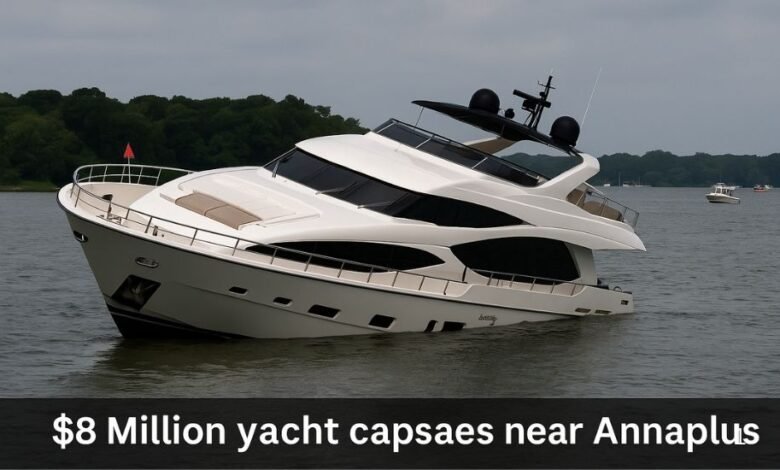$8 Million Yacht Capsizes Near Annapolis: Why the Lovebug Sank

When headlines broke with the words “$8 million yacht capsizes near Annapolis”, the maritime world was left stunned. The vessel in question, the Lovebug, was a luxury superyacht that had long been a symbol of wealth, exclusivity, and ocean-going glamour. Yet in late July 2024, this dream vessel became a nightmare as it partially sank in the Chesapeake Bay, near the mouth of the West River outside Annapolis, Maryland.
The story quickly spread far beyond boating circles, raising questions not only about what went wrong, but also about the wider safety of superyachts. Many began asking: what caused the Lovebug to sink? what caused the super yacht to capsize? who owned the yacht that capsized? what happens when a yacht capsizes? how many super yachts have sunk? and how to survive a sinking yacht?
This article explores each of these questions in depth, offering a complete picture of one of the most high-profile yacht accidents in recent memory.
What Caused the Lovebug to Sink / What Caused the Super Yacht to Capsize?
The Lovebug did not meet its fate in stormy seas or through a violent collision. Instead, its downfall came from a simple but catastrophic oversight: an open watertight door.
The superyacht’s design included a garage at the stern where jet skis and smaller watercraft could be stored. Investigators later determined that this garage door had been left partially open. Compounding the problem, a watertight door leading from the garage to the engine room was also open. This created an open channel between the sea and the vessel’s vital systems.
Seawater began to pour in unnoticed, flooding compartments that should have remained sealed. Within minutes, the Lovebug began listing heavily. Witnesses described the yacht leaning at an angle of nearly 50 degrees, with alarms blaring and furniture sliding across decks.
The captain attempted to steer into shallower waters, but the flooding had already destroyed stability. Engines failed, systems shut down, and within four minutes the Lovebug was beyond saving. The $8 million yacht capsizes near Annapolis became more than a headline—it became a case study in the importance of watertight integrity.
Who Owned the Yacht That Capsized?
The Lovebug was a privately owned yacht but was often chartered to wealthy clients for holidays and events. Reports valued the yacht at $8 million, with weekly charter rates near $125,000. Built in 2010 and refitted in 2021, it was known for its sleek modern design, lavish interiors, and the ability to host 11 guests with a crew of 7–8 members.
While the exact private owner has not been publicly confirmed, the yacht had a strong reputation in the charter market. Its partial sinking was not only a personal financial loss but also a blow to the superyacht industry, where reputation and luxury experiences are paramount.
What Happens When a Yacht Capsizes?
To the casual observer, yachts look invincible—towering, stable, and engineered for both beauty and performance. Yet the Lovebug’s sudden collapse shows just how quickly things can change when water enters a vessel where it shouldn’t.
When seawater floods multiple compartments, the vessel’s center of buoyancy shifts dramatically. This is what causes a yacht to list, tilt, or roll over. Once the Lovebug took on water through its garage and engine room, it lost the delicate balance between weight and displacement.
Alarms sounded across the yacht as the tilt increased. Guests and crew scrambled for safety as systems shut down. The captain made a distress call while steering for shallow water, but the effort came too late.
Ultimately, the Lovebug came to rest on its starboard side in about 12 feet of water, partially submerged and grounded in Chesapeake Bay mud. The visual of a half-sunken luxury yacht served as a stark reminder that when a yacht capsizes, events unfold rapidly and dangerously.
How Many Super Yachts Have Sunk?
The phrase “$8 million yacht capsizes near Annapolis” is shocking because superyacht accidents of this kind are rare. Only a small percentage of the world’s thousands of luxury yachts have ever sunk or capsized.
That said, there have been other high-profile losses over the years:
-
Flooding incidents caused by open hatches or structural failures.
-
Fires that spread quickly and forced abandonment.
-
Collisions with rocks, reefs, or other vessels.
-
Extreme weather, such as hurricanes or typhoons, overwhelming even large ships.
The Lovebug stands out not because of violent conditions but because its sinking was so avoidable. In calm waters, with no storm in sight, the fate of this yacht was sealed by something as preventable as leaving a watertight door open.
How to Survive a Sinking Yacht?
The survival of everyone aboard the Lovebug shows how training and quick thinking can turn disaster into rescue. Here are key lessons:
1. Stay Calm and Follow Orders
Panic clouds judgment. Passengers who listened to crew instructions had the best chance of survival.
2. Don Life Jackets Immediately
Every passenger should wear a personal flotation device as soon as alarms or instructions are given.
3. Issue a Distress Signal
The captain made a MAYDAY call, alerting nearby vessels and the Coast Guard to the emergency.
4. Abandon Ship When Necessary
With the Lovebug tilting beyond recovery, abandoning ship was the only option. Passengers jumped into the water and were quickly assisted.
5. Group Together and Stay Visible
Remaining in groups, signaling with lights or whistles, and staying calm ensured everyone could be rescued swiftly.
6. Trust Rescuers and Nearby Boats
Nearby recreational boats and tour vessels were quick to respond, pulling passengers to safety and preventing any casualties.
This incident shows that how to survive a sinking yacht is not about luck—it is about preparation, discipline, and the professionalism of the crew.
The Lessons of the Lovebug
The $8 million yacht capsizes near Annapolis story has become more than just a news headline. It has sparked conversations across the maritime industry about safety, training, and the importance of adhering to basic operational rules.
Superyachts symbolize freedom, luxury, and indulgence. Yet the Lovebug’s capsizing is a reminder that they are still ships, beholden to the same unforgiving laws of the sea as any vessel. A single mistake—an open door, a missed alarm, a delayed response—can turn millions of dollars of engineering into a stranded wreck.
Conclusion
The sinking of the Lovebug answers many pressing questions:
-
What caused the Lovebug to sink? – Flooding from an open watertight door and garage.
-
What caused the super yacht to capsize? – Unchecked seawater intrusion destroying stability.
-
Who owned the yacht that capsized? – A private owner who frequently chartered the vessel.
-
What happens when a yacht capsizes? – Rapid listing, power loss, and abandonment.
-
How many super yachts have sunk? – Relatively few, though every incident is a lesson.
-
How to survive a sinking yacht? – Quick action, distress calls, life jackets, and trained crews.
The image of the $8 million yacht capsizes near Annapolis will remain etched in maritime history, not only for the drama of the event but for the lessons it carries. Safety, vigilance, and respect for the sea remain more important than wealth, luxury, or size.
For more information visit News Zio



